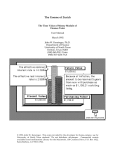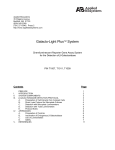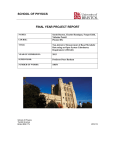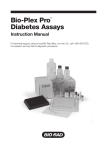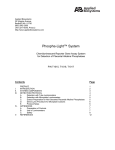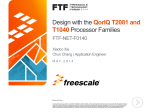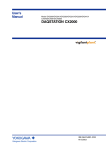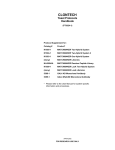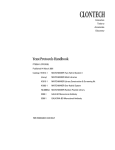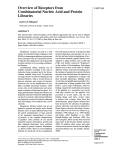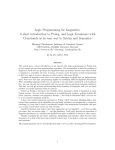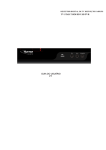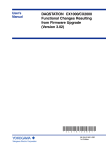Download "user manual"
Transcript
Applied Biosystems 35 Wiggins Avenue Bedford, MA 01730 (800) 542-2369 (781) 271-0045, Press 2 Galacto-Star™ System Chemiluminescent Reporter Gene Assay System for the Detection of β-Galactosidase P/N T1012, T1013, T1014, T1019, T1020 Contents I. II. III. IV. V. Page PREFACE……….......................................................................................... INTRODUCTION.......................................................................................... SYSTEM COMPONENTS............................................................................ β-GALACTOSIDASE DETECTION PROTOCOL......................................... A. Preparation of Mammalian Cell Extracts......................................... B. Preparation of Yeast Cell Extracts................................................... C. Direct Lysis Protocol for Microplate Cultures………………….…..... D. Detection Protocol for Tube Luminometers..................................... E. Detection Protocol for Microplate Luminometers............................. F. Protocol Notes………………………………………………………….. APPENDICES ……………………………………………………………………. A. Preparation of Controls............................................................................ B. Inactivation of Endogenous β-Galactosidase........................................... C. Use of Luminometers…………………………………………………………. D. Safety………………...…………………………………………………………. REFERENCES............................................................................................... 1 2 3 4 4 4 5 5 6 6 6 6 7 7 7 12 Part Number T9017 Revision D Revision Date: October 2008 For Research Use Only. Not for use in diagnostic procedures. Information in this document is subject to change without notice. APPLIED BIOSYSTEMS DISCLAIMS ALL WARRANTIES WITH RESPECT TO THIS DOCUMENT, EXPRESSED OR IMPLIED, INCLUDING BUT NOT LIMITED TO THOSE OF MERCHANTABILITY OR FITNESS FOR A PARTICULAR PURPOSE. TO THE FULLEST EXTENT ALLOWED BY LAW, IN NO EVENT SHALL APPLIED BIOSYSTEMS BE LIABLE, WHETHER IN CONTRACT, TORT, WARRANTY, OR UNDER ANY STATUTE OR ON ANY OTHER BASIS FOR SPECIAL, INCIDENTAL, INDIRECT, PUNITIVE, MULTIPLE OR CONSEQUENTIAL DAMAGES IN CONNECTION WITH OR ARISING FROM THIS DOCUMENT, INCLUDING BUT NOT LIMITED TO THE USE THEREOF, WHETHER OR NOT FORESEEABLE AND WHETHER OR NOT APPLIED BIOSYSTEMS IS ADVISED OF THE POSSIBILITY OF SUCH DAMAGES. Literature Citation: When describing a procedure for publication using this product, please refer to it as the Galacto-Star™ System. Trademarks: Applied Biosystems, AB (Design), Dual-Light, Galacton, Galacton Plus, Galacton-Star and Tropix are registered trademarks and Galacto-Star and Sapphire-II are trademarks of Applied Biosystems Inc. or its subsidiaries in the US and/or certain other countries. All other trademarks are the sole property of their respective owners. © Copyright 2008 Applied Biosystems. All rights reserved. PREFACE Safety Information Note: For general safety information, see this Preface and Appendix D, “Safety” on page 7. When a hazard symbol and hazard type appear by a chemical name or instrument hazard, see the “Safety” Appendix for the complete alert on the chemical or instrument. Safety Alert Words Four safety alert words appear in Applied Biosystems user documentation at point in the document where you need to be aware of relevant hazards. Each alert word—IMPORTANT, CAUTION, WARNING, DANGER—implies a particular level of observation or action, as defined below: IMPORTANT! – Indicates information that is necessary for proper instrument operation, accurate chemistry kit use, or safe use of a chemical. CAUTION! – Indicates a potentially hazardous situation that, if not avoided, may result in minor or moderate injury. It may also be used to alert against unsafe practices. WARNING! – Indicates a potentially hazardous situation that, if not avoided, could result in death or serious injury. DANGER! – Indicates an imminently hazardous situation that, if not avoided, will result in death or serious injury. This signal word is to be limited to the most extreme situations. MSDSs The MSDSs for any chemicals supplied by Applied Biosystems are available to you free 24 hours a day. For instructions on obtaining MSDSs, see MSDSs on page 8. IMPORTANT! For the MSDSs of chemicals not distributed by Applied Biosystems contact the chemical manufacturer. How to Obtain Support For the latest services and support information for all locations, go to: www.appliedbiosystems.com At the Applied Biosystems web site, you can: • Access worldwide telephone and fax numbers to contact Applied Biosystems Technical Support and Sales facilities. • Search through frequently asked questions (FAQs). • Submit a question directly to Technical Support. • Order Applied Biosystems user documents, MSDSs, certificates of analysis, and other related documents. • Download PDF documents. • Obtain information about customer training. • Download software updates and patches. 1 I. INTRODUCTION The Tropix® Galacto-Star™ chemiluminescent reporter assay system is designed for rapid and sensitive detection of β-galactosidase activity in cell lysates. The assay incorporates Tropix Galacton-Star® substrate for β-galactosidase with Tropix Sapphire-II™ luminescence enhancer to produce glow light emission kinetics. The Galacto-Star assay has a wide dynamic range, enabling detection from 2 fg to 20 ng of purified β-galactosidase (1). The system is ideally suited for use with either mammalian or yeast cells. The Galacto-Star assay provides a simplified method for detecting βgalactosidase. Cell lysate is incubated with Reaction Buffer containing Galacton-Star and Sapphire-II enhancer until maximum light emission is reached (typically 30-90 min, depending upon assay temperature (Fig. 1)); after peak, light emission remains constant for nearly 1 hour. Light signal is measured in a luminometer without the need for reagent injection. A direct lysis protocol for measurement of β-galactosidase activity in microplate cell cultures is also provided. The bacterial β-galactosidase gene is widely used as a reporter enzyme for the study of gene regulation. Tropix chemiluminescent 1,2-dioxetane substrates for βgalactosidase, including Galacton® (product discontinued), Galacton-Plus® and GalactonStar ®, provide highly sensitive enzyme detection (1-4) and have been utilized in reporter assays in both mammalian cell culture and tissue extracts, and Galacton-Plus substrate is incorporated in a combined assay for firefly luciferase and β-galactosidase activities in cell extracts (5,6; Dual-Light® assay system, P/N T1000). Chemiluminescent reporter assays may be conducted in cells or tissues that have endogenous β-galactosidase. Reduction of endogenous activity may be achieved using heat inactivation (7). Tissue extracts may require the use of protease inhibitors (8). Applications The Galacto-Star assay system is used widely for traditional reporter gene assays in transfected mammalian cells (9-11), and in insect cells (12). A wide variety of applications have been performed, including viral function assays with β-Gal-encoding pseudovirions (13) and MAGI cells (14,15), normalization of siRNA transfection (16), and as a reporter read-out for epitope recognition by an engineered CTL hybridoma cell line (17). The Galacto-Star system has been used to assay tissues extracts of transgenic mice made with β-gal-tagged mouse embryonic stem cells (18,19). The system is also formatted for use with yeast cells, and is ideally suited for reporter gene assays in yeast (20), or the study of protein:protein interactions with the yeast two-hybrid system (21,22). Galacton-Star substrate has been used for reporter gene assays in bacterial cells with modified lysis reagents (23). Two novel applications demonstrated have been a cell death assay, by measurement of β-gal released into culture media (24), and a stop codon read-through assay using a constitutively-expressed β-gal-luciferase fusion construct (25). The Galacto-Star assay system has wide application to cell-based assays that use β-gal reporter as a read-out for gene expression in many cell types and tissues from whole animals, or as a functional read-out for viral function, immune cell activation, cell death, and mRNA processing. 2 Figure 1. Galacto-Star assays were performed with purified β-galactosidase (500 pg). Repeated measurements were made with the Applied Biosystems TR717™ microplate luminometer at either room temperature (25°C) or 30°C. Data is presented as the percentage of the maximum signal. The dotted line indicates 95% of maximum signal. II. SYSTEM COMPONENTS Shelf-life for all Galacto-Star™ kit components is 1 year at 4°C. Microplate assays per kit Lysis Solution OR 5X Z Buffer Galacton-Star substrate Reaction Buffer Diluent T1012, T1019 600 70 mL 80 mL 1.2 mL 60 mL T1014 1800 210 mL 240 mL 3.6 mL 180 mL T1013, T1020 15,000 1.75 L 2L 30 mL 1.5 L 1. Lysis Solution: 100 mM potassium phosphate (pH 7.8), 0.2% Triton X-100 (for mammalian cells, in T1012, T1014, T1013). OR 5X Z Buffer: 0.5 M sodium phosphate (pH 7.1), 50 mM KCl, 5 mM MgSO4 (for yeast cells, in T1019, T1020). 2. Galacton-Star® substrate: 50X concentrate. 3. Reaction Buffer Diluent: 100 mM sodium phosphate (pH 7.5), 1 mM magnesium chloride, 5% Sapphire-II enhancer. 3 III. β-GALACTOSIDASE DETECTION PROTOCOL Please read the entire Protocol and Notes sections before proceeding. A. Preparation of Mammalian Cell Extracts Non-adherent cells should be pelleted and rinsed. Sufficient Lysis Solution should be added to cover the pellet; then the cells should be resuspended by pipetting. Continue at Step 5 below. For the following hazards, see the complete safety alert descriptions in Appendix D “Safety” on page 7: WARNING! CHEMICAL HAZARDS. Lysis Solution. B. 1. Add DTT (to 0.5 mM) to the required volume of Lysis Solution (if desired, see Note 1). 2. Rinse cell cultures twice with PBS. 3. Add Lysis Solution to cover cells. Use 250 μl per 60 mm plate. 4. Detach cells from plate with a cell scraper. 5. Transfer the cell lysate to a microfuge tube and centrifuge for 2 min to pellet debris. 6. Transfer extract (supernatant) to a fresh tube. Use immediately or store at −70°C. Preparation of Yeast Cell Extracts 1. Dilute 5X Z Buffer 1:5 in H2O. Add DTT to 0.5 mM (if desired, see Note 1). 2. Transfer 1.5 mL of yeast culture (OD600 = 0.5) to a microfuge tube. Centrifuge at 12,000g for 30 sec. If OD600 is < 0.4, use > 1.5 mL. 3. Remove supernatant and resuspend cell pellet in 1.5 mL of 1X Z Buffer. 4. Centrifuge at 12,000g for 30 sec. 5. Remove supernatant and resuspend pellet in 300 μl of 1X Z Buffer. 6. Transfer 100 μl to a fresh tube. Store the remainder at 4°C. 7. Perform 2 freeze/thaw cycles. Freeze in liquid N2 for 60 sec. Thaw cells at 37°C for 60 sec. 8. Centrifuge at 12,000g for 5 min at 4°C. 9. Transfer supernatant to a fresh tube. Use immediately or store at -70°C. 4 C. Direct Lysis Protocol for Microplate Cultures This procedure is designed for adherent cels growing in 96-well tissue culture-treated luminometer plates. Perform assays in triplicate at room temperature. Heat inactivation of endogenous β-galactosidase activity is not effective with this protocol. For the following hazards, see the complete safety alert descriptions in Appendix D “Safety” on page 7: WARNING! CHEMICAL HAZARDS. Lysis Solution. D. 1. Add DTT (to 0.5 mM) to the required volume of Lysis Solution (if desired, see Note 1). 2. Rinse cells once with PBS. 3. Add 10 μl of Lysis Solution to each well and incubate for 10 min. 4. Continue with the procedure for Detection with Microplate Luminometers (Section E), omitting Step 2. Detection with Tube Luminometers Perform assays in triplicate at room temperature. For the following hazards, see the complete safety alert descriptions in Appendix D “Safety” on page 7: WARNING! CHEMICAL HAZARDS. Reaction Buffer Diluent. 1. Dilute Galacton-Star® substrate 1:50 with Reaction Buffer Diluent to make Reaction Buffer. Prepare only enough for daily use (300 μL/tube). Equilibrate to room temperature. 2. Transfer 2-20 μL of extract to luminometer tubes (see Note 2). 3. Add 300 µl of Reaction Buffer, mix, and incubate for 30-90 min until light emission is maximal (see Figure 1 and Note 3). 4. Measure signal in a luminometer for 0.1-1 sec/tube. 5 E. Detection with Microplate Luminometers Perform assays in triplicate at room temperature. For the following hazards, see the complete safety alert descriptions in Appendix D “Safety” on page 7: WARNING! CHEMICAL HAZARDS. Reaction Buffer Diluent. F. 1. Dilute Galacton-Star® substrate 1:50 with Reaction Buffer Diluent to make Reaction Buffer. Prepare only enough for daily use (200 μL/well). Equilibrate to room temperature. 2. Transfer 2-10 μL of extract to microplate wells (see Note 2). 3. Add 100 μL of Reaction Buffer, mix, and incubate for 30-90 min until light emission is maximal (see Figure 1 and Note 3). 4. Measure signal in a luminometer for 0.1-1 sec/well. Protocol Notes 1. Dithiothreitol (DTT) may be added to Lysis Solution (to 0.5 mM) to stabilize β-galactosidase activity. However, DTT may increase assay background, and high concentrations will decrease light emission half-life. If low background and extended half-life is critical, DTT should be omitted. 2. The amount of extract required may vary depending on the β-galactosidase expression level. Use 2-5 μL or 10-20 μL of extract for samples with high or low levels of enzyme, respectively. 3. Measurements can be performed after 20-30 min if the time between Reaction Buffer addition and light measurement is the same for all samples. IV. APPENDICES A. Preparation of Controls Positive Control Reconstitute lyophilized β-galactosidase (Sigma G-5635) to 1 mg/mL in 0.1 M sodium phosphate (pH 7.0), 0.1% BSA. Store at 4°C. Generate a standard curve by serially diluting in Galacto-Star Lysis Buffer or Z Buffer containing 0.1% BSA. 2-20 ng of enzyme should be used as an upper detection limit. Purified enzyme provides a positive control for the assay reagents, as well as a means to determine the range of detection of the luminometer instrumentation, if desired. The purified enzyme standard curve is not intended (or accurate) for absolute quantitation of reporter enzyme concentrations, as the specific activity of the purified enzyme preparation and the reporter enzyme may differ significantly. Additional positive controls can include use of control βgalactosidase constructs that provide constitutive expression of reporter enzyme as a positive control for cell transfection. Negative Control Assay a volume of mock-transfected extract equivalent to that of experimental extract to determine endogenous cellular background. In experiments involving induction of reporter expression, uninduced cells should be assayed as a negative control for total assay background. 6 B. Inactivation of Endogenous β-Galactosidase Some cell lines exhibit endogenous β-galactosidase activity. This may lead to high background which will decrease the sensitivity of the assay. A procedure for heat inactivation of endogenous β-galactosidase activity has been described (17). A modified version of this protocol has also been described for use with tissue extracts in which protease inhibitors are used in conjunction with the heat inactivation procedure (18). These procedures should be performed prior to the Detection Protocol. Inactivation of β-Galactosidase Activity 1. Heat the extract for 50-60 min at 48°C. 2. Proceed with detection (Section IIIC or IIID). NOTE: PMSF (to 0.2 mM) and leupeptin (to 5 µg/mL) may be added to Lysis Solution just before use if protease activity may be present. NOTE: AEBSF (a water-soluble analog of PMSF; Sigma A-8456) may replace of PMSF (Sigma P-7626). Leupeptin (Sigma L-2884) is recommended. C. Use of Luminometers We recommend using a single-mode luminometer or a multi-mode detection insturment set for luminescence measurement to measure the light emission from 96- or 384-well microplates. The linear range of detection will vary according to cell type and on the reporter enzyme expression level. The number of cells or sample volume used per well should be optimized to prevent a measurement signal that is outside the linear range of the luminometer. Extremely high light signals can saturate the detector (very unlikely for experimental samples), resulting in erroneous measurements. Refer to your luminometer user’s manual, and use the positive control serial dilution curve to determine the upper limit for your specific luminometer. Contact Applied Biosystems Technical Support for additional questions. D. Safety GENERAL CHEMICAL SAFETY Chemical hazard warning WARNING! CHEMICAL HAZARD. Before handling any chemicals, refer to the Material Safety Data Sheet (MSDS) provided by the manufacturer, and observe all relevant precautions. WARNING! CHEMICAL HAZARD. All chemicals in the instrument, including liquid in the lines, are potentially hazardous. Always determine what chemicals have been used in the instrument before changing reagents or instrument components. Wear appropriate eyewear, protective clothing, and gloves when working on the instrument. 7 WARNING! CHEMICAL HAZARD. Four-liter reagent and waste bottles can crack and leak. Each 4-liter bottle should be secured in a low-density polyethylene safety container with the cover fastened and the handles locked in the upright position. Wear appropriate eyewear, clothing, and gloves when handling reagent and waste bottles. WARNING! CHEMICAL STORAGE HAZARD. Never collect or store waste in a glass container because of the risk of breaking or shattering. Reagent and waste bottles can crack and leak. Each waste bottle should be secured in a low-density polyethylene safety container with the cover fastened and the handles locked in the upright position. Wear appropriate eyewear, clothing, and gloves when handling reagent and waste bottles. Chemical safety guidelines To minimize the hazards of chemicals: • Read and understand the Material Safety Data Sheets (MSDSs) provided by the chemical manufacturer before you store, handle, or work with any chemicals or hazardous materials. (See “About MSDSs” on page 8.) • Minimize contact with chemicals. Wear appropriate personal protective equipment when handling chemicals (for example, safety glasses, gloves, or protective clothing). For additional safety guidelines, consult the MSDS. • Minimize the inhalation of chemicals. Do not leave chemical containers open. Use only with adequate ventilation (for example, fume hood). For additional safety guidelines, consult the MSDS. • Check regularly for chemical leaks or spills. If a leak or spill occurs, follow the manufacturer’s cleanup procedures as recommended in the MSDS. • Comply with all local, state/provincial, or national laws and regulations related to chemical storage, handling, and disposal. MSDSs About MSDSs Chemical manufacturers supply current Material Safety Data Sheets (MSDSs) with shipments of hazardous chemicals to new customers. They also provide MSDSs with the first shipment of a hazardous chemical to a customer after an MSDS has been updated. MSDSs provide the safety information you need to store, handle, transport, and dispose of the chemicals safely. Each time you receive a new MSDS packaged with a hazardous chemical, be sure to replace the appropriate MSDS in your files. 8 Obtaining MSDSs The MSDS for any chemical supplied by Applied Biosystems is available to you free 24 hours a day. To obtain MSDSs: 1. Go to www.appliedbiosystems.com, click Support, then select MSDS. 2. In the Keyword Search field, enter the chemical name, product name, MSDS part number, or other information that appears in the MSDS of interest. Select the language of your choice, then click Search. 3. Find the document of interest, right-click the document title, then select any of the following: • Open – To view the document • Print Target – To print the document • Save Target As – To download a PDF version of the document to a destination that you choose Note: For the MSDSs of chemicals not distributed by Applied Biosystems, contact the chemical manufacturer. CHEMICAL WASTE SAFETY Chemical waste hazards CAUTION! HAZARDOUS WASTE. Refer to Material Safety Data Sheets and local regulations for handling and disposal. WARNING! CHEMICAL WASTE HAZARD. Wastes produced by Applied Biosystems instruments are potentially hazardous and can cause injury, illness, or death. WARNING! CHEMICAL STORAGE HAZARD. Never collect or store waste in a glass container because of the risk of breaking or shattering. Reagent and waste bottles can crack and leak. Each waste bottle should be secured in a low-density polyethylene safety container with the cover fastened and the handles locked in the upright position. Wear appropriate eyewear, clothing, and gloves when handling reagent and waste bottles. 9 Chemical waste safety guidelines To minimize the hazards of chemical waste: • Read and understand the Material Safety Data Sheets (MSDSs) provided by the manufacturers of the chemicals in the waste container before you store, handle, or dispose of chemical waste. • Provide primary and secondary waste containers. (A primary waste container holds the immediate waste. A secondary container contains spills or leaks from the primary container. Both containers must be compatible with the waste material and meet federal, state, and local requirements for container storage.) • Minimize contact with chemicals. Wear appropriate personal protective equipment when handling chemicals (for example, safety glasses, gloves, or protective clothing). For additional safety guidelines, consult the MSDS. • Minimize the inhalation of chemicals. Do not leave chemical containers open. Use only with adequate ventilation (for example, fume hood). For additional safety guidelines, consult the MSDS. • Handle chemical wastes in a fume hood. • After emptying a waste container, seal it with the cap provided. • Dispose of the contents of the waste tray and waste bottle in accordance with good laboratory practices and local, state/provincial, or national environmental and health regulations. Waste disposal If potentially hazardous waste is generated when you operate the instrument, you must: • Characterize (by analysis if necessary) the waste generated by the particular applications, reagents, and substrates used in your laboratory. • Ensure the health and safety of all personnel in your laboratory. • Ensure that the instrument waste is stored, transferred, transported, and disposed of according to all local, state/provincial, and/or national regulations. IMPORTANT! Radioactive or biohazardous materials may require special handling, and disposal limitations may apply. 10 BIOLOGICAL HAZARD SAFETY General biohazard WARNING! BIOHAZARD. Biological samples such as tissues, body fluids, infectious agents, and blood of humans and other animals have the potential to transmit infectious diseases. Follow all applicable local, state/provincial, and/or national regulations. Wear appropriate protective equipment, which includes but is not limited to: protective eyewear, face shield, clothing/lab coat, and gloves. All work should be conducted in properly equipped facilities using the appropriate safety equipment (for example, physical containment devices). Individuals should be trained according to applicable regulatory and company/institution requirements before working with potentially infectious materials. Read and follow the applicable guidelines and/or regulatory requirements in the following: – U.S. Department of Health and Human Services guidelines published in Biosafety in Microbiological and Biomedical Laboratories (stock no. 017-040-00547-4; bmbl.od.nih.gov) – Occupational Safety and Health Standards, Bloodborne Pathogens (29 CFR§1910.1030; www.access.gpo.gov/nara/cfr/waisidx_01/29cfr1910a_01.html). – Your company’s/institution’s Biosafety Program protocols for working with/handling potentially infectious materials. IMPORTANT! Additional information about biohazard guidelines is available at: www.cdc.gov CHEMICAL ALERTS For the definitions of the alert words IMPORTANT, CAUTION, WARNING, and DANGER, see “Safety alert words” on page 1. General alerts for all chemicals EXAMPLE: Avoid contact with (skin, eyes, and/or clothing). Read the MSDS, and follow the handling instructions. Wear appropriate protective eyewear, clothing, and gloves. 11 Specific chemical alerts WARNING! CHEMICAL HAZARD. Lysis Solution causes eye, skin, and respiratory tract irritation. Avoid breathing vapor. Use with adequate ventilation. Avoid contact with eyes and skin. Read the MSDS, and follow the handling instructions. Wear appropriate protective eyewear, clothing, and gloves. WARNING! CHEMICAL HAZARD. Reaction Buffer Diluent may cause eye, skin, and respiratory tract irritation. Read the MSDS, and follow the handling instructions. Wear appropriate protective eyewear, clothing, and gloves. V. 1. 2. 3. 4. 5. 6. 7. 8. 9. 10. 11. 12. 13. 14. REFERENCES Martin, CS, CEM Olesen, B Liu, JC Voyta, JL Shumway, R-R Juo and I Bronstein (1997). Continuous sensitive detection of β-galactosidase with a novel chemiluminescent 1,2-dioxetane. In Bioluminescence and Chemiluminescence: Molecular Reporting with Photons (Hastings, JW, Kricka, LJ and Stanley, PE, eds.), p. 525-528. John Wiley, Chichester, England. Bronstein, I, J Fortin, JC Voyta, CEM Olesen and LJ Kricka (1994). Chemiluminescent reporter gene assays for β-galactosidase, β-glucuronidase and secreted alkaline phosphatase, p. 20-23. In Bioluminescence and Chemiluminescence: Fundamentals and Applied Aspects (Campbell, AK, Kricka, LJ, and Stanley, PE, eds), John Wiley, Chichester, England Bronstein, I, CS Martin, JJ Fortin, CEM Olesen and JC Voyta (1996). Chemiluminescence: sensitive detection technology for reporter gene assays. Clin Chem 42(9):1542-1546. Jain, VK and IT Magrath (1991). A chemiluminescent assay for quantitation of -galactosidase in the femtogram range: Application to quantitation of β-galactosidase in lacZ-transfected cells. Anal Biochem 199:119-124. Bronstein, I, CS Martin, CEM Olesen and JC Voyta (1997). Combined luminescent assays for multiple enzymes, p. 451-457. In Bioluminescence and Chemiluminescence: Molecular Reporting with Photons (Hastings, J.W., Kricka, L.J. and Stanley, P.E., eds.), John Wiley, Chichester, England. Martin, CS, PA Wight, A Dobretsova and I Bronstein. 1996. Dual luminescence-based reporter gene assay for luciferase and β-galactosidase. BioTechniques 21(3):520-524. Young, DC, SD Kingsley, KA Ryan and FJ Dutko (1993). Selective inactivation of eukaryotic βgalactosidase in assays for inhibitors of HIV-1 TAT using bacterial β-galactosidase as a reporter enzyme. Anal Biochem 215:24-30. Shaper, N, A Harduin-Lepers and JH Shaper (1994). Male germ cell expression of murine β4galactosyltransferase. A 796-base pair genomic region, containing two cAMP-responsive element (CRE)-like elements, mediates male germ cell-specific expression in transgenic mice. J Biol Chem 269: 25165-25171. De Bosscher, K, CS Hill and FJ Nicolas (2004). Molecular and functional consequences of Smad4 Cterminal missense mutations in colorectal tumour cells. Biochem J 379:209-216. Pittler, SJ, Y Zhang, S Chen, AJ Mears, DJ Zack, Z Ren, PK Swain, S Yao, A Swaroop and JB White (2004). Functional analysis of the rod photoreceptor cGMP phosphodiesterase α-subunit gene promoter. J Biol Chem 279(19):19800-19807 Fan, S, M Gao, Q Meng, JJ Laterra, MH Symons, S Coniglio, RG Pestell, ID Goldberg and EM Rosen (2005). Role of NF-κB signaling in hepatocyte growth factor/scatter factor-mediated cell protection. Oncogene 24:1749-1766. Silver, SJ, EL Davies, L Doyon and I Rebay (2003). Fucntional dissection of eyes absent reveals new modes of regulation within the retinal determination gene network. Mol Cell Biol 23(17):5989-5999. Simmons, G, AJ Rennekamp, N Chai, LH Vandenberghe, JL Riley and P Bates (2003). Folate receptor alpha and caveolae are not required for Ebola virus glycoprotein-mediated viral infection. J Virol 77(24):13433-13438. Fouts, T, K Godfrey, K Bobb, D Montefiori, CV Hanson, VS Kalyanaraman, A DeVico and R Pal (2002). Crosslinked HIV-1 envelope-CD4 receptor complexes elicit broadly cross-reactive neutralizing antibodies in rhesus macaques. Proc Natl Acad Sci USA 99(18):11842-11847. 12 15. 16. 17. 18. 19. 20. 21. 22. 23. 24. 25. Kensinger, RD, BJ Catalone, FC Krebs, B Wigdahl and C-L Schengrund (2004). Novel polysulfated galactose-derivatized dendrimers as binding antagonists of Human Immunodeficiency Virus Type 1 infection. Antimicrob Agents Chemotherapy 48(5):1614-1623. Keeton, EK and M Brown (2005). Cell cycle progression stimulated by tamoxifen-bound estrogen receptor-α and promoter-specific effects in breast cancer cells deficient in N-CoR and SMRT. Mol Endocrinol 19(6):1543-1554. Serna, A, MC Ramirez, A Soukhanova and LJ Sigal (2003). Cutting edge: Efficient MHC class I cross-presentation during early vaccinia infection requires the transfer of proteasomal intermediates between antigen donor and presenting cells. J Immunol 171:5668-5672. Rokosh, DG and PC Simpson (2002). Knockout of the α1A/C-adrenergic receptor subtype: The α1A/C is expressed in resistance arteries and is required to maintain arterial blood pressure. Proc Natl Acad Sci USA 99(14):9474-9479. Farhadi, HF, P Lepage, R Forghani, HCH Friedman, W Orfali, L Jasmin, W Miller, TJ Hudson and AC Peterson (2003). A combinatorial network of evolutionarily conserved Myelin Basic Protein regulatory sequences confers distinct glial-specific phenotypes. J Neurosci 23(32):10214-10223. Olesnicky, NS, AJ Brown, SJ Dowell and LA Casselton (1999). A constitutively active G-proteincoupled receptor causes mating self-compatibility in the mushroom Coprinus. EMBO J 18:27562763. Daub, M, J Jockel, T Quack, CK Weber, F Schmitz, UR Rapp, A Wittinghofer and C Block (1998). The RafC1 cysteine-rich domain contains multiple distinct regulatory epitopes which control Rasdependent Raf activation. Mol Cell Biol 18:6698-6710. Scharf, KD, H Heider, I Hohfeld, R Lyck, E Schmidt and L Nover (1998). The tomato Hsf system: HsfA2 needs interaction with HsfA1 for efficient nuclear import and may be localized in cytoplasmic heat stress granules. Mol Cell Biol 18(4):2240-2251. Singh, MP and M Greenstein (2005). A simple, rapid, sensitive method detecting homoserine lactone (HSL)-related compounds in microbial extracts. J Microbiol Methods 65(1):32-37. Schotte, P, G Denecker, A Van Den Broeke, P Vandenabeele, GR Cornelis and R Beyaert (2004). Targeting Rac1 by the Yersinia effector protein YopE inhibits caspase-1-mediated maturation and release of interleukin-1β. J Biol Chem 279(24):25134-25142. Carnes, J, M Jacobson, L Leinwand and M Yarus (2003). Stop codon suppression via inhibition of eRF1 expression. RNA 9:648-653. For complete reference list, please see http://www.appliedbiosystems.com (Product & Service Literature). 13















